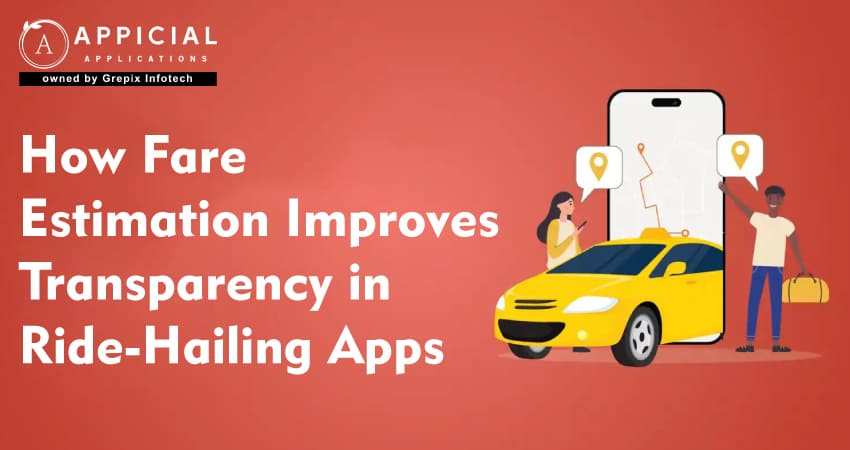
How Fare Estimation Improves Transparency in Ride-Hailing Apps
In today’s mobility ecosystem, users demand clarity. They expect to know what they will pay before they book. The availability of accurate fare estimation in a ride-hailing app or e-hailing app has become a differentiator. When riders use an Uber Clone or a white label taxi booking app, the ability to see a reliable fare estimate up front fosters trust. For businesses developing such platforms, partnering with a taxi app development company or a white label taxi app development company that integrates transparent pricing features is essential. This blog elaborates on how fare estimation plays a central role in transparency and why it matters for your ride-sharing app strategy.
In this blog, we examine why incorporating robust fare estimation in a ride-hailing app is critical. We discuss how accurate upfront cost prediction enhances transparency, boosts user trust, improves operational efficiency, and supports driver satisfaction. We cover statistical insights, key benefits, implementation considerations, common challenges, and how a taxi app development company or white label taxi app development company can build those capabilities into your Uber Clone or ride-sharing app.
Why Does Fare Estimation Matter for Transparency?
What transparency means in ride-hailing settings
Transparency in the context of ride-hailing means that both passengers and drivers are aware of how costs are calculated and what they can expect. It means the ride-sharing app clearly presents the expected fare, shows any surcharges or extra time/distance charges, and avoids surprises post-trip. For a ride-hailing app, this clarity builds trust, reduces disputes, and supports user retention. When your Uber Clone offers transparent fare estimates, it stands out among competitors. A white label taxi booking app built by a strong taxi app development company should embed this feature from day one.
How inaccurate or hidden fares harm trust
When fare estimates are absent or poorly calculated, riders can feel cheated. Unexpected surges, opaque add-ons or last-minute changes undermine confidence. Academic research indicates drivers and riders often perceive pricing algorithms as opaque and unfair. If a ride-hailing app fails to provide accurate fare estimation, it may see higher cancellation rates, lower ratings, and decreased loyalty. A poorly built Uber Clone without fare transparency risks negative word of mouth.
Fairness and accountability to drivers and riders
Transparent fare estimation isn’t just for riders; it matters for drivers, too. A ride-sharing app that shows the driver how the fare is computed ensures they understand what they will earn. Research into algorithmic management of drivers in platforms like Uber highlights the opacity of fare calculations and their impact on driver earnings. When a taxi app development company incorporates real-time fare preview features, it supports fairness and reduces conflicts.
Regulatory and competitive imperatives
In many jurisdictions, regulators increasingly demand fare transparency in mobility services. Customer expectations also shift: riders expect to compare costs, time, and service across apps. As one article observed, transparency in rideshare pricing is becoming a competitive necessity. If your white label taxi app development company builds fare estimation as a core feature, your e-hailing app will be better positioned to comply and compete.
How precise fare estimation aligns with business metrics
From a business perspective, offering fare estimation enhances conversion rates (users willing to book when they know the cost), decreases cancellation/no-show rates, and supports demand forecasting. A well-implemented fare estimation module in a ride-hailing app allows the business to plan pricing strategies, manage driver incentives, and optimise supply. If your Uber Clone includes advanced fare estimation built by your taxi app development company, you gain operational stability and better metrics.
What Benefits Does Robust Fare Estimation Deliver?
Enhanced user satisfaction and retention
When riders get an accurate fare estimate at booking time, they feel in control. Knowing the cost upfront reduces anxiety and uncertainty. This fosters loyalty to your ride-sharing app. Users are more likely to use your e-hailing app again if each ride results in no surprise charges. Over time, your white label taxi booking app will build a reputation for fairness.
Improved driver engagement and performance
Drivers appreciate knowing how much they will earn before accepting a ride. When a ride-hailing app clearly displays earnings after subtracting commissions and surcharges, driver trust increases. This reduces driver churn and increases service reliability. A taxi app development company can design driver-side fare breakdowns as part of your Uber Clone.
Reduction in disputes and complaints
Many complaints in ride-hailing services arise from fare surprises or confusion about charges. Transparent fare estimation means fewer arguments post-ride, fewer service refunds, and less negative feedback. A white label taxi app development company should integrate a post-trip explanation of fare computation into its ride-sharing app to reduce support load.
Better operational efficiency and forecasting
With fare estimation, your platform can better forecast demand, rides, and revenue. Knowing average upcoming fares helps you model driver supply, idle time, pricing elasticity and demand scheduling. For your e-hailing app built as an Uber Clone, this means lower driver downtime and optimized driver deployment. A mature taxi app development company will integrate analytics into fare-estimation systems.
Competitive advantage and market differentiation
In a crowded market of ride sharing app offerings, transparency in fares is a differentiator. If your white label taxi booking app communicates clear, predictable pricing, it stands out. Riders opting between apps will lean toward one giving them a trustworthy estimate. A well-constructed fare-estimation module is thus a strategic asset for your Uber Clone.
What Does the Data Say About Fare Estimation and Transparency?
Research on pricing sensitivity and disclosure
A study on ride-hailing services found that most riders were price inelastic, with a price elasticity of approximately –0.2 to –0.1. This indicates that fare visibility and predictability can influence user decision-making. When users understand costs, they may choose scheduled rides, premium options, or alternate modes less frequently.
Studies on algorithmic opacity and fare unfairness
An empirical study of the platform Uber found that drivers often face opaque fare calculations, making it difficult to know how much they will earn and why. For a ride-hailing app or ride sharing app, transparent fare estimation addresses this issue by making pricing mechanisms more visible.
The growing market for ride-hailing and the relevance of transparency
The global ride-sharing market is projected to grow from around USD 149.9 billion in 2025 to USD 691.6 billion by 2034. Within such growth, user expectations for clarity and fairness will increase. For any e-hailing app or Uber Clone, building transparent fare estimation now is vital to scaling trust in a growing market.
Platforms for comparison and transparency tools
There are emerging services that allow riders to compare fares across providers and emphasise transparent pricing. This underscores that transparency is increasingly demanded by users and market players. For your white label taxi booking app, having robust fare estimation helps meet this trend.
How Do You Implement High-Quality Fare Estimation in Your Platform?
What inputs should the fare-estimation module use?
A reliable fare estimation module in a ride-hailing app or ride-sharing app requires several inputs: base fare, distance travelled, estimated travel time, surge or demand multipliers, tolls, wait time, traffic conditions, vehicle type, and service level. According to industry sources, taxi fare pricing data includes base fare, distance-based charges, time-based charges, surcharges, and dynamic pricing components. Your Uber Clone, built by a proficient taxi app development company, should incorporate all of these factors.
How should the UI/UX present estimated fares to users?
The user interface should display the estimated fare clearly before ride confirmation. It should indicate what the estimate covers, what could change (waiting time, route deviation, surge) and any additional surcharges. For a white-label taxi booking app, the estimate should not feel like an afterthought but be a core step in the booking flow. Clear, short statements like “Estimated fare: $ (may vary based on traffic)” help manage expectations. The design must match the standards of a trustworthy ride-hailing app experience.
How do you handle surge, dynamic pricing and last-minute changes?
Even with an estimate, prices may change due to real-time demand, traffic or other variables. The system must communicate this. For example, the estimate can include a message: “Fare may increase if traffic worsens or demand surges.” For your ride-sharing app, your taxi app development company should build logic to adjust estimates close to ride start if conditions change significantly and surface that to the user. The goal is not to eliminate variation entirely but to keep deviations minor and predictable.
How to integrate driver earnings visibility?
Estimating fare is only half of transparency. The driver should also see expected earnings (after fees and commissions) prior to trip acceptance. This empowers drivers and reduces conflict. For your Uber Clone, your white label taxi app development company should create driver-side dashboards showing breakdown: base fare, distance, time, commissions, etc.
What analytics should you build around fare estimation?
You should track metrics such as actual fare vs estimated fare deviations, user satisfaction with fare estimates, percentage of bookings dropped due to fare surprises, driver acceptance rate when earnings are clearly displayed. Your e-hailing app should feed this data into a prediction engine to refine estimates over time. A strong taxi app development company can build this loop into your solution.
How to scale fare estimation across regions and service levels?
If your white label taxi booking app serves multiple cities, vehicle classes or service tiers (standard, luxury, shared), fare estimation must adapt. Differences in base fares, traffic patterns, tolls and local regulations matter. Your ride sharing app architecture needs modular fare rules and dynamic config. Your taxi app development company should build a rule-engine for localised fare models.
What Common Challenges Arise in Fare Estimation and How to Address Them?
Dealing with variable traffic and route changes
Traffic congestion, detours, and unpredictable events make fare estimation difficult. To mitigate this, your ride hailing app should use real-time traffic data, historical patterns and buffer allowances. For example, the estimate might include a small buffer margin or show ranges (“₹ 250–300”). A taxi app development company must ensure the estimation engine is resilient and adaptive.
Addressing user perception when estimates are wrong
Even a well-built system will occasionally produce fare estimates that deviate from actual fares. The key is to keep deviations minimal and manage user expectations. Your ride sharing app should include messaging like “Actual fare may vary based on traffic, wait time or route changes.” For your white label taxi booking app, you might add fare change alerts or show how much difference arose and why. Transparency about the reason builds trust.
Complexity of surcharge and premium pricing
Late-night rides, airport pickups, event surcharges, tolls, peak demand multipliers all add complexity. A simplistic fare estimation engine might omit these and produce poor estimates. Your Uber Clone must incorporate all such conditions. A veteran taxi app development company will provide configurable modules for surcharges and time-based multipliers.
Balancing accuracy and speed of computation
Fare estimation must be fast (in seconds) to avoid user wait times in your ride hailing app. But to be accurate, it must process multiple variables. Your developers must optimise for speed while maintaining accuracy. When partnering with a white label taxi app development company, ensure they prioritise performance as well as precision.
Ensuring fairness and avoiding bias in algorithms
Studies show that algorithmic pricing in ride-hailing sometimes has disparate impacts based on geography or passenger demographics. To ensure fairness, your ride sharing app should audit its fare-estimation algorithms, provide transparency and avoid bias. The taxi app development company you choose must have expertise in algorithmic fairness and auditing.
What Questions Should You Ask When Selecting a Taxi App Development Partner?
Does the company have experience designing fare-estimation modules?
When your ride hailing app project is underway, ask your prospective taxi app development company if they have built fare-estimation engines, dynamic pricing modules or driver-earnings dashboards. A white label taxi app development company with this experience can accelerate your time-to-market and provide tested systems.
How do they ensure accuracy, speed and scalability?
Fare estimation must be accurate across thousands of trip requests and scale regionally. Ask how the partner ensures speed, manages traffic data, integrates with maps and routing engines, and scales across cities and service tiers. For your Uber Clone, this is critical.
How do they handle localisation of fare rules and surcharges?
Different cities have different fare rules, tolls, congestion charges. Your ride sharing app may serve multiple geographies, so your partner should show a method to configure local fare rules easily. A strong white label taxi booking app developer will offer such configurability.
What analytics and monitoring are included?
You should ask how the partner helps you monitor estimated vs actual fare deviations, user complaints about fare surprises, driver acceptance rates. A full-featured ride hailing app should include dashboards and alerts. The taxi app development company should support this.
How do they manage transparency and fairness concerns?
Given increased regulatory and user scrutiny, ask how the partner ensures fare estimation is transparent and audit-friendly. Do they include logs, explain why a fare changed, and provide driver and passenger breakdowns? This matters for your Uber Clone credibility.
Also Read: Trip Tracking: From Pickup to Drop – How HireMe Taxi Keeps Riders Informed
How Does Fare Estimation Fit into Your Overall Ride-Hailing App Strategy?
Integrating with schedule bookings and premium services
If your e-hailing app offers scheduled rides, shared rides, premium tiers (luxury, larger vehicles), the fare-estimation module must adapt accordingly. Scheduled rides often require buffer time and higher cost. A ride sharing app built via a capable taxi app development company will integrate fare estimation seamlessly into these variations.
Linking with driver incentives and reward programmes
Transparent fare estimates allow you to design driver incentive programmes (e.g., “earn extra for scheduled rides with low cancellation”). Your Uber Clone platform can use fare-estimation data to identify high-value trips and reward drivers accordingly. A reliable white label taxi app development company will support such business logic.
Marketing your transparency as a differentiator
Use the clarity of your fare-estimation feature as a marketing message. For example: “Know your fare before you ride” or “Transparent pricing, no hidden charges.” For your ride hailing app, this message builds trust and can reduce acquisition cost. Include this in onboarding of riders of your white label taxi booking app.
Supporting promotion and dynamic pricing strategies
Having a fare estimation foundation allows you to offer promotions (“Flat ₹50 off”) and quickly adjust pricing for demand surges. Your estimation engine can factor in discount codes or surge multipliers in real-time. For your ride sharing app, this flexibility is a business advantage.
Building for scale and future mobility models
As mobility evolves (electric vehicles, shared fleets, autonomous vehicles), fare estimation becomes more complex. Having an estimation engine already in place gives you a foundation to integrate future models. Your Uber Clone built with a forward-looking taxi app development company will be ready for these transitions.
Why Choose Appicial Applications for Your Ride-Hailing Solution with Transparent Fare Estimation
When you aim to build a ride-hailing app, ride-sharing app, or e-hailing app, focusing on fare estimation as a core feature is critical. That’s where Appicial Applications comes in as your ideal partner. Here’s why:
- Deep expertise in crafting holistic Uber Clone solutions that include transparent fare estimation modules.
- As a leading taxi app development company, Appicial Applications has built scalable fare engines, driver earnings dashboards and real-time analytics.
- Experience delivering white label taxi booking app solutions for multiple geographies, with localised fare rules, surcharges, dynamic pricing and transparency features.
- Strong UI/UX focus: fare estimation is presented clearly, simply and trustworthily in the rider flow and driver flow.
- Analytics and monitoring built in: you gain insights into estimated vs actual fare deviation, user complaints, and driver earnings metrics.
- Post-launch support and iterative enhancement so your ride-sharing app stays ahead of market expectations and regulatory demands.
Ready to launch a transparent, trust-driven ride-hailing platform? Contact Appicial Applications today for a free consultation. Let us help you build a full-featured Uber Clone or white label taxi booking app with built-in fare estimation and transparency features. Take the step toward a more trusted and efficient mobility solution.
Conclusion
Transparent fare estimation is no longer optional for modern ride-hailing platforms; it is a must-have. For riders, it means clarity, control and predictable costs. For drivers, it means visibility into their earnings and fairness. For businesses, it means deeper trust, better conversion, improved operational efficiency and competitive positioning. In the expanding mobility market, your ride-hailing app, ride-sharing app, or e-hailing app must integrate reliable fare estimation from the ground up.
Partnering with a seasoned taxi app development company or white label taxi app development company ensures you build this capability correctly. Appicial Applications stands ready to help you launch a transparent, scalable and future-proof mobility platform. Don’t wait, let’s build your success together.
FAQs
Author's Bio

Vinay Jain is the Founder at Grepix Infotech and brings over 12 years of entrepreneurial experience. His focus revolves around software & business development and customer satisfaction.
Back to blog list




